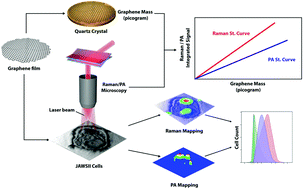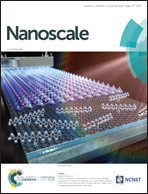Quantification of cellular associated graphene and induced surface receptor responses†
Abstract
The use of graphene for biomedical and other applications involving humans is growing and shows practical promise. However, quantifying the graphitic nanomaterials that interact with cells and assessing any corresponding cellular response is extremely challenging. Here, we report an effective approach to quantify graphene interacting with single cells that utilizes combined multimodal-Raman and photoacoustic spectroscopy. This approach correlates the spectroscopic signature of graphene with the measurement of its mass using a quartz crystal microbalance resonator. Using this technique, we demonstrate single cell noninvasive quantification and multidimensional mapping of graphene with a detection limit of as low as 200 femtograms. Our investigation also revealed previously unseen graphene-induced changes in surface receptor expression in dendritic cells of the immune system. This tool integrates high-sensitivity real-time detection and monitoring of nanoscale materials inside single cells with the measurement of induced simultaneous biological cell responses, providing a powerful method to study the impact of nanomaterials on living systems and as a result, the toxicology of nanoscale materials.



 Please wait while we load your content...
Please wait while we load your content...
